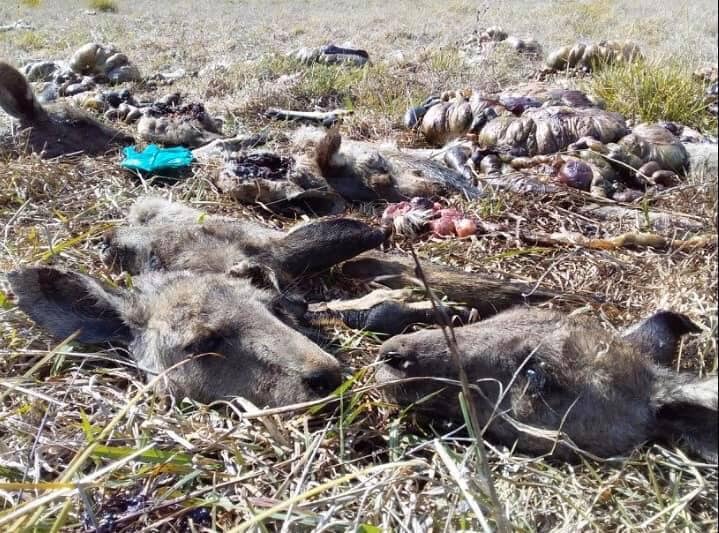The SA Commercial Kangaroo Management Plans breach the Environment Protection and Biodiversity Conservation Act 1999 (EPBC Act) and the National Parks and Wildlife Act 1972 (NPW Act) and should never have been approved. The approval of the South Australian Commercial Kangaroo Management Plans breaches the EPBC Act 1999 and the NPW Act.
A study of the Quota Reports for Commercial Kangaroo Harvest in South Australia from 2012 to 2020 reveals that:
- the harvest zones of Marla – Oodnadatta, Marree (outside dog fence), Murray Mallee, Eyre West and Eyre East are meant to be surveyed every three years. However, these surveys have not been completed. According to released reports, these zones have not been surveyed during the last decade.
- the harvest zones of Kingoonya and Marree (inside dog fence) were not surveyed during 2017 due to a harvest below 50% for the previous five years. When the harvest falls below 50% for the previous five-years the implication is low kangaroo numbers. Instead of surveying these zones, the SA government chose to suspend annual surveys.
- quotas set decimate kangaroo populations. For instance:
- in the 2019 Quota Report, the estimated population of red kangaroos in the mid-north zone was 6,227. According to Hacker et al (2004) this population of kangaroos was at risk of extinction. In 2019, the quota was set at 1,000 and 1,500 in 2020.
- in the 2019 Quota Report, the estimated population of western grey kangaroos in the North-East Pastoral zone was 91,828. A year later, the estimated population was 20,756. Numbers fell by 71,072 or 78%. Even so, the 2020 quota was set at 10% or 2,100.
A wildlife trade can only be approved if it complies with the EPBC Act Sect 303FN (3) (b) the operation will not be detrimental to: (i) the survival of a taxon to which the operation relates. “Taxon” means any taxonomic category (for example, a species or a genus), and includes a particular population.
SECT 303FO of the EPBC Act, an approved wildlife management plan, states that (3) The Minister must not declare a plan under subsection (2) unless the Minister is satisfied that: (a) the plan is consistent with the objects of this Part; and (b) there has been an assessment of the environmental impact of the activities covered by the plan, including (but not limited to) an assessment of: (i) the status of the species to which the plan relates in the wild…
In 2008, the NT Department of Natural Resources, Environment and the Arts concluded that the sustainable commercial harvest of kangaroos in the Northern Territory is not feasible at this time because kangaroo densities in the Northern Territory are low (1–5 kangaroos/km) to very low (0.1–1 kangaroos/km).
In 2020, red kangaroo densities in South Australia for 5 harvest zones are low (1–5 kangaroos/km) and very low for 6 harvest zones (0–1 kangaroos/km). Only 2 out of the 13 harvest zones have red kangaroo densities higher than 5 kangaroos/km.
In 2020, western grey kangaroo densities in South Australia for 5 harvest zones are low (1–5 kangaroos/km) and very low for 6 harvest zones. Only 2 out of the 13 harvest zones have western grey kangaroo densities higher than 5 kangaroos/km.
In 2020, the Queensland government announced a suspension on the killing of eastern grey kangaroos in the following harvest zones: Central North, Central South and Western. The suspension was announced due to kangaroo densities in these regions being low ((1–5 kangaroos/km) to very low (0–1 kangaroos/km).
In 2020, the NSW government closed four harvest zones for all or some species as a result of kangaroo densities falling below 5 kangaroos/km.
While QLD and NSW governments suspend the harvest of kangaroos when numbers fall below 5 kangaroos/km, the SA government continues the commercial harvest and expands the industry. The QLD and NSW governments work within state and federal legislation, suspending the commercial harvest to ensure the survival of kangaroos. In direct violation of state and federal legislation, the SA government continues and expands the commercial harvest, threatening the future of kangaroo populations.
Clearly the SA Commercial Kangaroo Management Plans breach state and federal legislation because assessments of the status of the species hasn’t been done in a minimum of five harvest zones and the operation will be detrimental to kangaroos due to quotas being set on kangaroo densities considered low and very low. The commercial harvest of kangaroos in South Australia should have been suspended in 2020. Instead, the commercial harvest was expanded to include 2 additional species and all of South Australia.

On another note, according to the Commercial Harvest of Kangaroos Code of Practice, adult kangaroos must be humanely killed by a single gunshot to the head. The above photo reveals that very few kangaroos are killed in this manner. The heads are cut off kangaroos so that no one can tell if a single head shot was the cause of death or not.